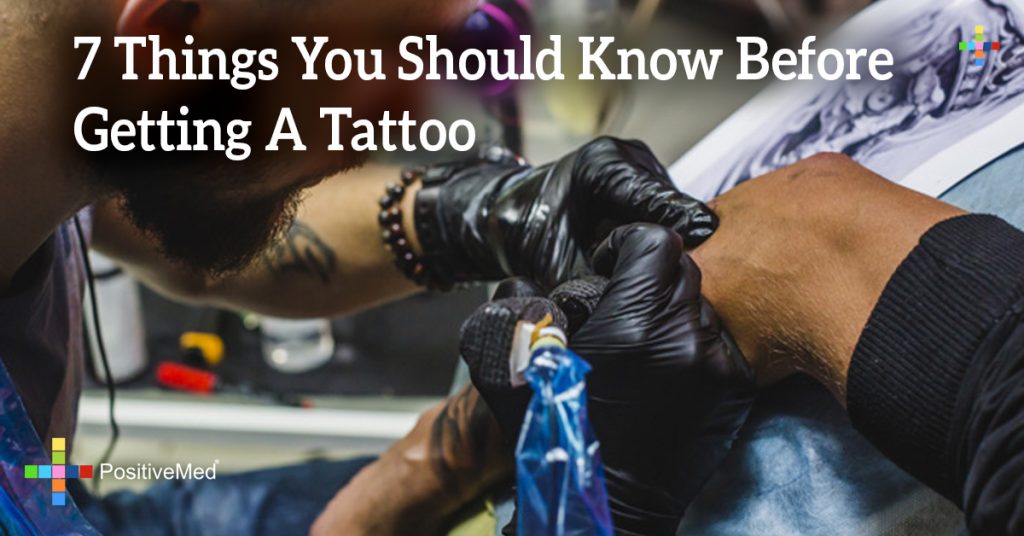
7 Things You Should Know Before Getting A Tattoo
Tattoos are forever. They talk about your personality and can be beautiful art, but there are risk factors associated with getting a tattoo. Americans are among the most tattooed people in the world. Here are some important things you should consider, especially if you are about to get your first tattoo.
1-Licensed tattoo artist
This is the most important step in the entire process. Research for tattoo parlors that are registered and an artist who holds a license. Since this process involves the use of needles make sure that all needles are removed from a sterile single-use package before using them. Artists should wash hands well before starting the process. You can get advice from friends who have tattoos.

2-Be sure about getting a tattoo
Tattoos last until your last breath and the decision to be tattooed should be firm. Don’t make this decision in a hurry as you may regret it in time. Getting rid of a permanent tattoo is a complex procedure which is harsh on your pocket as well.
3-Be extremely careful about hygiene
While getting your tattoo make sure your artist uses fresh needles out of sterile single-use packets. Ensure the artist washes his/her hands properly and uses sanitizer. Wearing sterile gloves is also recommended.
4-Avoid alcohol
Do not drink alcohol the night before getting inked. Use of drugs like aspirin is also prohibited while getting tattooed. Alcohol makes the blood thinner which increases the volume of blood that comes out during needling.
5-Check your tattoo location
Where on your body you get a tattoo is as important as the design. If you are getting your first tattoo avoid areas that have more nerve endings and more pain, like your face, some employers flat out refuse to hire someone with facial or neck tattoos, and some professions do not allow any that are visible, like healthcare and food service, if you like your job check the policy. If your endurance levels are low choose body parts that are more fleshy. Getting tattoos on bony areas like the top of your foot or your spine or ribcage is painful.
6-Care for your tattoo
When you go to get your tattoo wear loose clothing to avoid anything rubbing against the tattoo. Ask someone to accompany you to the tattoo parlor. Talking to someone places concentration away from pain and makes it easier to bear. Use the ointment prescribed by your artist and wash your tattoo twice daily. Avoid dirt and contact with chemicals like pool chlorine and avoid exposure to direct sunlight. Winter is the recommended season for getting tattoos.
7-Be prepared for pain
Pain is an integral part of getting the tattoo especially for tattoo virgins, it depends on your pain threshold. Its a good idea to concentrate on something else that can take your attention away from pain.
Like everything else, getting tattooed has some risk

The biggest risk is the risk of infection which cannot be completely averted even when using sterile needles. Infections usually occur from bacteria contaminating the tattoo site. Common symptoms of infection are red rashes, swelling, and pain. Infections usually occur 2-3 weeks after getting the tattoo. Most are treated by using antibiotics, however severe cases might require a doctor’s attention.
Some people are allergic to ink. Allergic reactions can occur just after getting the tattoo or after months or years after being inked. Tattoos can also worsen any skin condition you might have.
Some have reported little bumps on their skin. These bumps develop because our body might treat the ink as a foreign substance and try to remove it. There is a chance that the ink will enter your body, hazards of which are unknown.
Some interesting facts about tattoos:

1. Per a recent study, more women have tattoos than men. The percentage of women and men are 59 and 41 respectively.
2. The process of getting a tattoo involves four stages: outlining, shading, color cleaning, and bandaging.
3. The pigments and inks used in tattoos are not approved by US Food and Drug Association. Some tattoo parlors are regulated by the state, so it is at your discretion.
4. After getting your tattoo, ask your artist to give you a card with instructions for taking care of your skin and tattoo as they can be painful and risky.
5. About 1/5 of those who get tattoos regret it, so be careful and sure before you decide to get one.
6. If you see some scabbing after your tattoo, that is normal. Do not pick them as they will fall off on their own within 3 weeks. If you notice an infection, see your doctor.
Best locations for getting a tattoo:

- 1. Inner wrist
- 2. Ankle
- 3. Ear
- 4. Behind the ear
- 5. Inner arm
- 6. Inner bicep






